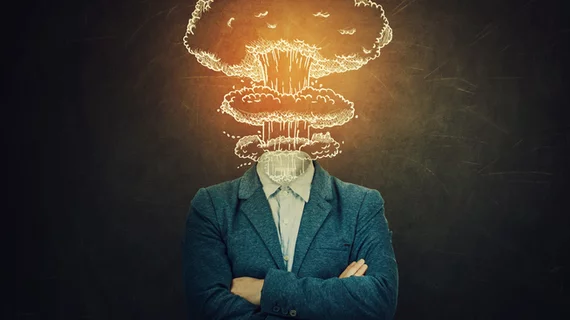Frequent AI use may increase radiologists’ risk of burnout
Artificial intelligence—billed as a way to relieve burnout among busy radiologists—may actually be contributing to it, according to research published Friday in JAMA Network Open [1].
The problem is particularly pronounced among members of the specialty who already have a high workload or are skeptical of AI. Chinese researchers made these determinations after fielding a survey of 6,726 radiologists over a seven-month period ending in May.
“These results underscore the need to reassess the role of AI technology in mitigating radiologist burnout,” Hui Liu, PhD, with the Chinese Academy of Medical Sciences & Peking Union Medical College, Beijing, and co-authors wrote Nov. 22. “Balancing AI use with an appropriate radiology workforce and maintaining psychological acceptance of AI technology in clinical practice is essential,” they added.
Physician burnout has become a global issue, the authors noted, driven by work overload, an imbalance between time spent at home and on the job, and general career dissatisfaction. Radiologists have exhibited higher rates of burnout when compared to other medical specialties, previous research has shown.
To better understand these dynamics, Liu and co-authors conducted a cross-sectional study to obtain a nationally representative sample of radiologists. They utilized the National Center for Quality Control of Radiology network, which operates a system of surveillance across mainland China. They selected 1,143 hospitals and enrolled 1 to 5 radiologists from each. Those who met the criteria had to be between the ages of 20 to 74 and on the job for at least one year prior to the survey.
Nearly 65% of study subjects were male, with an overall median age of 41 and median practice duration of 16 years. Of the study sample, 3,017 radiologists regularly or consistently used AI in practice. This group was generally younger in age, more likely to be female and had higher educational levels. The weighted prevalence of burnout was significantly higher in the AI group (40.9%) when compared with the rest (38.6%).
When adjusting for certain factors, AI was significantly associated with increased odds of burnout (odds ratio 1.2). This primarily stemmed from emotional exhaustion (OR 1.21), driven by “elevated work demands and overload.” Liu and colleagues observed a noteworthy association between the frequency of AI use and burnout. These associations stood out even more for radiologists with heavy workloads and lower AI acceptance rates.
Researchers believe their study is one of the first to investigate the association between AI use and radiologist burnout using a large, nationwide, cross-sectional sample. Prior studies have suggested that AI use may cut radiologists’ workload in cancer screening by between 40% to 90%. However, the authors noted the difference between this and regular clinical care, which may require more radiologist time for differential diagnoses.
“Furthermore, the increased workload attributed to AI often results from elevated postprocessing and interpretation times. Our study underscores a critical knowledge gap, demonstrating a positive association between AI use and radiologist burnout, which longitudinal studies should further explore,” the authors wrote.
Liu et al. also expressed concern that AI could potentially add to the isolation and sedentary lifestyle some radiologists already face.
“AI may further exacerbate these challenges by diminishing opportunities for peer collaboration and patient interaction, while fears of job displacement and uncertainties surrounding AI use heighten stress,” according to the study.
In a corresponding editorial [2], Mayo Clinic experts said it may not be the AI causing burnout. Rather, burned out radiologists in the study are using artificial intelligence to try and relieve this stress. Future longitudinal or randomized analyses could help to better ascertain whether AI use exacerbates or alleviates burnout.
“This article highlights that the healthcare community has not yet learned how to effectively work with AI to harness the power of AI to reduce burnout,” Farid Ghareh Mohammadi, PhD, and Ronnie Sebro, MD, PhD, concluded. “The nuances of [human-machine interaction] are still in its infancy, and until we are more effective at HMI, AI will not be a panacea to reduce radiologist burnout.”
Read much more in JAMA at the link below.

